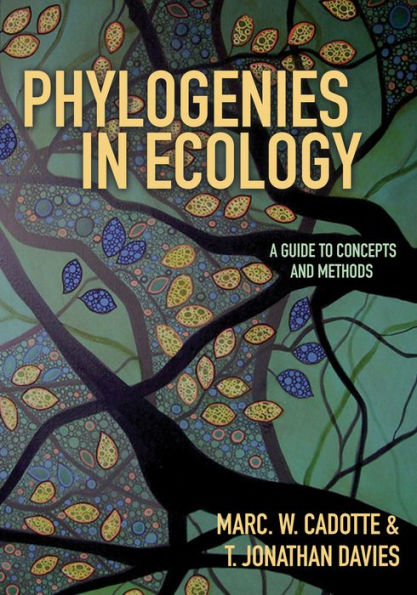
Phylogenies in Ecology: A Guide to Concepts and Methods
264
Phylogenies in Ecology: A Guide to Concepts and Methods
264Hardcover
-
PICK UP IN STORECheck Availability at Nearby Stores
Available within 2 business hours
Related collections and offers
Overview
Cadotte and Davies systematically look at all the main areas of current ecophylogenetic methodology, testing, and inference. Each chapter of their book covers a unique topic, emphasizes key assumptions, and introduces the appropriate statistical methods and null models required for testing phylogenetically informed hypotheses. The applications presented throughout are supported and connected by examples relying on real-world data that have been analyzed using the open-source programming language, R.
Showing how phylogenetic methods are shedding light on fundamental ecological questions related to species coexistence, conservation, and global change, Phylogenies in Ecology will interest anyone who thinks that evolution might be important in their data.

Product Details
| ISBN-13: | 9780691157689 |
|---|---|
| Publisher: | Princeton University Press |
| Publication date: | 08/09/2016 |
| Pages: | 264 |
| Product dimensions: | 7.10(w) x 10.10(h) x 0.80(d) |
About the Author
Table of Contents
Preface ix
CHAPTER 1 An Entangled Bank: Evolutionary Relationships and Ecological Patterns 1
1.1. Systematics and the Diversity of Life 2
1.2. The Origins 3
1.3. “Correcting” Ecological Comparisons 6
1.4. The Emergence of Ecophylogenetics 7
1.5. The Goal of This Book 8
CHAPTER 2 Building and Using Phylogenies 10
2.1. Handling Phylogenies in R 11
2.2. Building Trees 19
2.3. Finding and Adapting Available Trees 31
2.4. Tree Scaling and Rate Smoothing 33
2.5. Conclusion 40
CHAPTER 3 Phylogenetic Patterns within Communities: Inferring Mechanisms of Ecological Assembly Using Phylogenetic Distances 41
3.1. Phylogenetic Distances and Community Assembly 44
3.2. Calculating Community Diversity Metrics 55
3.3. A Note about Phylodiversity Measures—Moving from the Causes to the Consequences of Diversity 65
3.4. Conclusion 66
CHAPTER 4 Randomizations, Null Distributions, and Hypothesis Testing 67
4.1. A Brief History of Randomization Tests in Ecology (or the Simberloffian Shift in Ecology) 72
4.2. How to Build Null Communities 76
4.3. Randomizing Phylogenetic Data 83
4.4. Taking the Pool Seriously 96
4.5. Conclusion 99
CHAPTER 5 Detecting Patterns of Trait Evolution 100
5.1. Phylogenetic Signal 101
5.2. Alternative Models of Trait Evolution 108
5.3. Reconstructing Ancestral States 115
5.4. Conclusion 120
CHAPTER 6 The Geography of Speciation and Character Displacement 121
6.1. Character Divergence and Geographic Overlap 122
6.2. Community-Wide Trait Dispersion 133
6.3. Conclusion 141
CHAPTER 7 Phylogenetic Diversity across Space and Time 143
7.1. Phylobetadiversity: Measuring Phylogenetic Turnover 145
7.2. The Influence of Spatial Scale on Phylogenetic Patterns 161
7.3. Conclusion 170
CHAPTER 8 Speciation, Extinction, and the Distribution of Phylogenetic Diversity 172
8.1. Conservation of the Tree of Life 172
8.2. Macroevolution: Diversification 181
8.3. Conclusion 194
CHAPTER 9 Using Phylogenetic Information to Make Better Conservation Decisions 196
9.1. Why Preserve Evolutionary History? 197
9.2. Quantifying Evolutionary History 201
9.3. Prioritizing Species Based on Evolutionary Distinctiveness 204
9.4. Prioritizing Hotspots of Evolutionary Distinctiveness 207
9.5. Applying Conservation Metrics 208
CHAPTER 10 Conclusion: Where To From Here? 209
10.1. Predicting Ecology from Evolutionary Patterns 210
10.2. Combining Trait and Phylogenetic Information 212
10.3. Phylogenetic Insights into a Changing World 213
10.4. Where To Go from Here? 216
10.5. Heralding the Ecology-Evolution Synthesis? 221
Glossary 223
References 225
Index 249
What People are Saying About This
"A history lesson, textbook, and lab manual all in one, this terrific book explores the concepts and methods at the intersection of ecology and phylogenetics, from community ecology to conservation. Perfect for experienced researchers and students new to the field."—David Ackerly, University of California, Berkeley"This how-to manual is a comprehensive review and an important, encouraging, and evenhanded critique of ecophylogenetics. Cadotte and Davies give examples of the full range of ecophylogenetic analyses, which a reader can easily execute, learn from, and then use to create new ways for incorporating phylogenetic information to better understand the workings of organismal assemblages. A super book."—Campbell Webb, Harvard University"With scope and rigor, this book makes a compelling case that there are indeed ways to gain insights into important ecological questions using phylogenetic methods. A significant contribution to the field, the book presents new conceptions of how community assembly and evolutionary history interact, as well as new interpretations of data. This work provides a clear blueprint for moving the field ahead and will greatly catalyze future work."—Mathew Leibold, University of Texas, Austin
